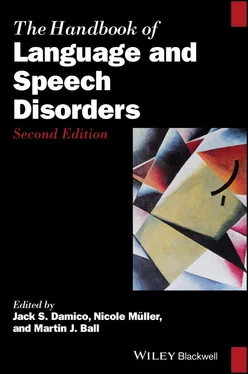51 Damico, J. S. (2019). Anchored assessment. In J. S. Damico & M. J. Ball (Eds.), The SAGE Encyclopedia of human communicative sciences and disorders (pp. 135–139). Thousand Oaks, CA: Sage.
52 Damico, J. S., & Augustine, L. E. (1995). Social considerations in the labeling of students as attention deficit hyperactivity disordered. Seminars in Speech and Language, 16, 259–274.
53 Damico, J. S., Müller, N., & Ball, M. J. (2004). Owning up to complexity: A sociocultural orientation to attention deficit hyperactivity disorder. Seminars in Speech and Language, 25, 277–285.
54 Danziger, K. (1990). Constructing the subject: Historical origins of psychological research. Cambridge, UK: Cambridge University Press.
55 Darley, F. L. (1975). Aphasia without adjectives. In F. L. Darley (Ed.), Aphasia (pp. 1–54). Philadelphia, PA: Saunders.
56 Deyhle, D. (1987). Learning failure: Tests as gatekeepers and the culturally different child. In H. T. Trueba (Ed.), Success or failure? Learning and the language minority student (pp. 85–108). Cambridge, MA: Newbury House.
57 Department of Education. (2002). Twenty‐fourth Annual Report to Congress on the Implementation of the Individuals with Disabilities Education Act. Washington, DC: United States Department of Education.
58 Dollaghan, C. (2004). Taxometric analysis of specific language impairment in 3‐ and 4‐year old children. Journal of Speech, Language, and Hearing Research, 47, 464–475.
59 Duchan, J. (2010). An open letter to the journal. Journal of Interactional Research in Communication Disorders, 1, 157–164.
60 Dudley‐Marling, C., & Dippo, D. (1995). What learning disabilities does: Sustaining the ideology of schooling. Journal of Learning Disabilities, 28, 408–414.
61 Edwards, S., & Bastiaanse, R. (2007). Assessment of aphasia in a multi‐lingual world. In M. J. Ball & J. S. Damico (Eds.), Clinical aphasiology. Future directions (pp. 245–258). New York, NY: Psychology Press.
62 Elliott, J., & Grigorenko, E. L. (2014). The dyslexia debate. New York, NY: Cambridge University Press.
63 Erchak, G. M., & Rosenfeld, R. (1989). Learning disabilities, dyslexia, and the medicalization of the classroom. In J. Best (Ed.), Images of issues (pp. 79–97). New York, NY: Aldine de Gruyter.
64 Erikson, K. T. (1962). Notes on the sociology of deviance. Social Problems, 9, 307–314.
65 Erikson, K. T. (1966). Wayward puritans. New York, NY: Wiley.
66 Fairbanks, C. M. (1992). Labels, literacy, and enabling learning: Glenn’s story. Harvard Educational Review, 62, 475–493.
67 Fine, M. (1991). Framing dropouts: Notes on the politics of an urban public high school. Albany, NY: State University of New York Press.
68 Flower, R. M. (1984). Delivery of speech‐language and audiology services. Baltimore, MD: Williams & Wilkins.
69 Fombonne, E. (2003). Epidemiological surveys of autism and other pervasive developmental disorders: An update. Journal of Autism and Developmental Disorders, 33, 365–382.
70 Forness, S. R. (1976). Behavioristic orientation to categorical labels. Journal of School Psychology, 14, 90–95.
71 Fox, P. (1989). From senility to Alzheimer’s disease: The rise of the Alzheimer’s movement. Milbank Quarterly, 67, 58–102.
72 Fraser, L., & Christopher, B. (2007). Is the use of labels in special education helpful? Support for Learning, 22, 36–42.
73 Frattura, E., & Capper, C. A. (2006). Segregated programs versus integrated comprehensive service delivery for all learners: Assessing the differences. Remedial and Special Education, 27(6), 355–364.
74 Gelb, S. A., & Mizokawa, D. T. (1986). Special education and social structure: The commonality of “exceptionality”. American Educational Research Journal, 23, 543–557.
75 Gergen, K. J., & Davis, K. E. (Eds.) (1985). The social construction of the person. New York, NY: Springer.
76 Gernsbacher, M. A., Dawson, M., & Goldsmith, H. H. (2005). Three reasons not to believe in an autism epidemic. Current Directions in Psychological Science, 14(2), 55–58.
77 Gibbs, S., & Elliott, J. (2015). The differential effects of labelling: How do ‘dyslexia’ and ‘reading difficulties’ affect teachers’ beliefs. European Journal of Special Needs Education, 30, 323–337.
78 Gill, V. T., & Maynard, D. W. (1995). On “Labeling” in actual interaction: Delivering and receiving diagnoses of developmental disabilities. Social Problems, 42(1), 11–37.
79 Gillman, M., Heyman, B., & Swain, J. (2000). What's in a name? The implications of diagnosis for people with learning difficulties and their family carers. Disability and Society, 15(3), 389–409.
80 Gipps, C. (1999). Socio‐cultural aspects of assessment. Review of Research in Education, 24, 355–392.
81 Glaser, R., & Silver, E. (1994). Assessment, testing, and instruction: Retrospect and prospect. In L. Darling‐Hammond (Ed.), Review of research in education (Vol. 20, pp. 393–421). Washington, DC: American Educational Research Association.
82 Goffman, E. (1964). Stigma: Notes on the management of spoiled identity. New York, NY: Simon and Schuster, Inc.
83 Goldstein, H. (1996). Statistical and psychometric models for assessment. In H. Goldstein & T. Lewis (Eds.), Assessment: Problems, developments and statistical issues (pp. 41–54). Chichester, UK: Wiley.
84 Goodman, N. (1978). Ways of world making. Indianapolis, IN: Hackett Publishing Company.
85 Goodwin, C. (2014). Foreword. In M. J. Ball, N. Müller, & R. L. Nelson (Eds.), Handbook of qualitative research in communication disorders (pp. xi–xv). New York, NY: Psychology Press.
86 Gould, S. J. (1996). The mismeasure of man (Revised and expanded ed.). New York, NY: W.W. Norton & Company.
87 Grigorenko, E. L. (2009). Dynamic assessment and response to intervention. Two sides of one coin. Journal of Learning Disabilities, 42, 111–132.
88 Gross, J. (1994). Asperger syndrome: A label worth having? Educational Psychology in Practice, 10(2), 104–110.
89 Guendouzi, J., & Müller, N. (2006). Approaches to discourse in dementia. Mahwah, NJ: Lawrence Erlbaum Associates.
90 Gus, L. (2000). Autism: Promoting peer understanding. Educational Psychology in Practice, 16(4), 461–468.
91 Gutkin, T. B., & Nemeth, C. (1997). Selected factors impacting decision in prereferral intervention and other school‐based teams: Exploring the intersection between school and social psychology. Journal of School Psychology, 35, 195–216.
92 Halpern, S. A. (1990). Medicalization as a professional process: Postward trends in pediatrics. Journal of Health and Social Behavior, 31, 28–42.
93 Hamayan, E., Marler, B., Sanchez‐Lopez, C., & Damico, J. (2013). Special education considerations for English language learners: A handbook for intervention teams (2nd ed.). Philadelphia, PA: Caslon Publishing.
94 Heise, D. R. (2007). Expressive order: Confirming sentiments in social actions. New York, NY: Springer.
95 Hood, L., McDermott, R., & Cole, M. (1980). “Let’s try to make it a good day”—some not so simple ways. Discourse Processes, 3, 155–168.
96 Iran‐Nejad, A. (1995). Constructivism as substitute for memorization in learning: Meaning is created by learner. Education, 116, 16–31.
97 Jensen, P. S., Mrazek, M. D., & Knapp, P. K. (1997). Evolution and revolution in child psychiatry: ADHD as a disorder of adaptation. Journal of the American Academy of Child and Adolescent Psychiatry, 36, 1672–1679.
98 Kamhi, A. G. (2014). Improving clinical practices for children with language and learning disorders. Language, Speech, and Hearing Services in Schools, 45, 92–103.
99 Kaufmann, J. M., Hallahan, D. P., & Lloyd, J. W. (1998). Politics, science, and the future of learning disabilities. Learning Disabilities Quarterly, 21, 276–270.
Читать дальше












